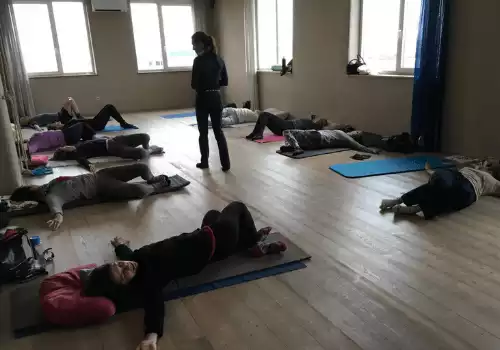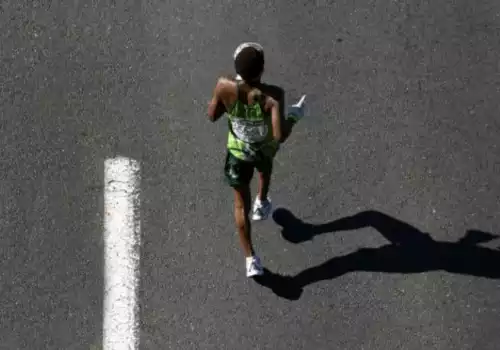What is herniated disc (spinal disc herniation)?
The intervertebral disc consists of a jelly-like center (nucleus pulposus) and an outer fibrous ring. After puberty, because the disc is not vascularized and therefore has more reduced ability to regenerate, degenerative changes begin to occur. First degenerative changes appear with the loss of water, as a consequence, the height of the intervertebral discs is reduced, and cracks in the rubbery outer ring may occur. A herniated disc occurs when some of the nuclei push out through a tear in the outer ring and presses on the nerve; it is also called a slipped disc or ruptured disc (spinal disc herniation).The intervertebral disc consists of a jelly-like center (nucleus pulposus) and an outer fibrous ring. After puberty, because the disc is not vascularized and therefore has more reduced ability to regenerate, degenerative changes begin to occur. First degenerative changes appear with the loss of water, as a consequence, the height of the intervertebral discs is reduced, and cracks in the rubbery outer ring may occur. A herniated disc occurs when some of the nuclei push out through a tear in the outer ring and presses on the nerve; it is also called a slipped disc or ruptured disc (spinal disc herniation).
According to Dr Vengusta, spinal disc herniation affects relatively young people, most commonly occurring between the ages of 25 and 45. The disc usually herniates in the morning when it is better hydrated and thus has a larger volume. Then, even sneezing or getting out of bed can cause the jelly-like core to penetrate through the crack. Therefore, it is a micro-injury or micro-pressure that causes the pressure of the nucleus on the nerve. Excessive strain or trauma also affects the increased incidence of herniation, with the leading cause being genetic factors and weakness of connective tissue.
What is the incidence of spinal disc herniation? From 3 to 4 per cent, it occurs at all ages, even at 12-year-olds, and even at a late age, if a person still has his intervertebral discs preserved. 90 % of herniation occurs in the lumbar spine, 10 % in the cervical spine, and a small proportion in the thoracic spine. Namely, the load on the intervertebral discs is the greatest in the lumbar spine.
AEQ method as prevention
There are structural changes when it comes to herniated disc condition, which will be dealt with by modern medicine. Namely, the reason for the intense pain and limitation of movement is not in the sensory-motor amnesia, but the pressure of the gelatinous nucleus on the nerve and the AEQ method is powerless in such a situation. AEQ has a preventive role primarily. It reduces the likelihood of the spinal disc herniation, especially if the predisposition is passed on to offspring, as well as the likelihood of herniation recurring after the surgery.
Spinal disc herniation is a result of the inability to regulate the tone of the trunk muscles, especially the abdominal and back muscles. In almost all cases of disc herniation in the lumbar spine, the average tone of these muscle groups is too high and lasting, leading to a loss of normal pulse of the pressure on the spine (higher when under strain and stress, lower when resting or sleeping). The pressure on the intervertebral discs is constantly increased, the intervertebral discs lose flexibility and a certain amount of water – higher pressure on the vertebrae expels water from the disc. This condition occurs due to the sensory-motor amnesia and chronic subconscious patterns that keep the muscles tense even when there is no real need for it (e.g. when sleeping).
Learning the AEQ method makes it possible to understand the laws of the body’s relationships and awareness. We understand how a condition occurs when we lose the otherwise naturally given ability to manage the skeletal muscle tone consciously. This understanding makes it possible to change the way we think about the causes of disc herniation, and thus take a different approach to prevent it from occurring or recurring.
AEQ exercises are structured to gradually increase the interest of consciousness for the sensations from the body and thus increase the transfer of proprioception and interception to the conscious part of the cerebral cortex. This gradually reduces the sensory-motor amnesia as we detect when the torso muscle tone is excessive. AEQ exercises make us more aware of what we do and how we do it. This allows us to define better whether what we are doing is right or wrong, and thus continue with the right actions and change the wrong ones. During the exercise, we have ideal conditions for real feelings and flows between the consciousness and the body. Usually, we have an inferior perception of the lumbar region of the back and the lower abdomen. Ability to separate the thigh muscles and the torso muscles are equally poor, too.
It is important to distinguish between the back pain and spinal disc herniation. However, it is true that chronic back pain increases the likelihood of disc herniation. More about the back pain: https://aeqeurope.com/conditions/back_pain/
The same principles but different circumstances and reactions to the environment are the reason for the disc herniation in the cervical spine (neck). More about the common reasons for neck pain: https://aeqeurope.com/conditions/neck_pain/
By learning the AEQ method, a new relationship between the body and consciousness is established, allowing for a gradual decrease in muscle tone and pressure on the intervertebral discs. Moreover, this eliminates the cause of disc herniation or recurrence in the years following the surgery.
In order to understand the AEQ method approach, it is necessary to distinguish between strengthening the muscle tone and improving control over the muscle tone. Strengthening is recommended when trying to eliminate the back pain, or in rehabilitation after the surgery, as it is assumed that the disc herniation is caused by the weak muscles, especially of the abdomen. Most often, however, it turns out that a person’s muscles are ineffective because they are always tense and hence there is no need to strengthen these muscles but to use an approach that will allow a person to gain proper control over them first.
Usually, people with disc herniation also experience irregular breathing: excessively shallow breaths, inefficient breathing, and chest tightness. Therefore, when breathing, there is no adequate expansion of the chest and thus the horizontal movement of the ribs inwards and outwards, which prevents the vertical movement (up and down) of the vertebrae in the thoracic part of the spine. All of this leads to reduced spinal fluid exchange and increased likelihood of disc herniation.
If the herniated disc is a result of a physical injury (a fall, a car accident …), the approach is different, and we focus primarily on eliminating the trauma reflex that was created to protect the injured part of the spine. AEQ teachers of levels 3, 4, and 5 are eligible for this work.
Teacher of the AEQ method Level 1 will be successful at milder and brief chronic stiffness in the lumbar spine and pelvis, or at teaching the exercises to reduce back problems.
Teacher of the AEQ breathing Level 1 helps when breathing is severely distorted and a person with shallow breathing controls anger, rage, and neurotic reactions to his/her surroundings. Using the AEQ breathing method, one can relieve the tensions in the chest and abdominal cavity very well and thus evokes positive effect on mild to moderate chronic stiffness. Combined with the knowledge of the AEQ method teachers of Levels 3 and 4 , it enables faster progress and more lasting results. Proper breathing gives a client an understanding of the pressure he or she is under and prevents the condition from worsening.
Teacher of the AEQ method Level 2 is well-suited with the knowledge to treat moderate conditions where the back pain persists for a long time, has receded several times, and then returned. Further, the Level 2 teacher can also help in moderate cases of sciatica, where the pain subsides after a few days. The Level 2 teacher is also qualified to teach the persons after the disc herniation surgery and the ones in physical therapy rehabilitation.
Teacher of the AEQ method Level 3 is successful in treating severe forms of stiffness/muscle tension when the pain is persistent and lasting, but the nucleus has not yet pushed through a tear and pressed on the nerve. Level 3 teacher also successfully participates in a rehabilitation program with physical therapy, or after the treatment; teacher helps a client to get a more profound sense of the SMA, which, as a result, gets eliminated faster. A teacher helps a client to understand the role of the AEQ exercises easier, as well as the need to change the lifestyle to reduce the causes of disc herniation.
Teacher of the AEQ method Level 4 or 5 can identify the causes of severe body stiffness and rigid membrane with the analysis of client’s relationships in childhood and adolescence. The pattern of over-indulgence and impulsivity that leads to disc herniation in adulthood is often transmitted from parent to child. Usually, such clients have severely repressed anger and rage and fear of expressing emotions. The consequences are high pressure in the abdominal cavity and stiffness and loss of spiral rotation between the pelvis and chest. Such condition and inability to maturely express anger leads to overwork, addiction to sports and forced introversion. All this can lead to problems in the lumbar spine early on.
Teacher of the AEQ method Level 4 or 5 is also proficient in working with fascia in accordance with the AEQ method, which eases adaptation of personality, relationships to oneself, and reactions to the environment. This can provide a client with a holistic approach that places the person with the problem in the center and takes into account his or her personal history.
The list of AEQ method teachers can be found here: https://aeqslovenija.com/
Aleš Ernst, author of the AEQ method and AEQ breathing






